
Orthopedics & Orthopedic Surgery (Bones)
Sports Medicine Conditions Treated in Faribault
A seamless care path helps you return to an active, pain-free life
Our highly trained experts work together to create a seamless, efficient pathway to recovery. This strategic team approach addresses your unique needs and goals, helps you get back in action sooner and includes:
- World-class, advanced treatment for existing injuries.
- A conservative approach to treatment whenever possible.
- Minimally invasive in-office procedures including ultrasound-guided injections for tendons and joints.
- Minimally invasive surgeries when appropriate.
- State-of-the-art rehabilitation equipment.
- Recommendations for injury prevention.
Personalized treatment for sports-related injuries and conditions
The sports medicine experts at Mayo Clinic Health System commonly treat:
- ACL tear
- Arthritis
- Concussion
- Dislocation
- Fractures and trauma
- Meniscus tear
- Muscle sprains
- Rotator cuff injury
- Ruptures and tears
- Tennis elbow
ACL tear
An ACL injury is a tear or sprain of the anterior cruciate (KROO-she-ate) ligament (ACL) — one of the major ligaments in your knee. ACL injuries most commonly occur during sports that involve sudden stops or changes in direction, jumping and landing — such as soccer, basketball, football and downhill skiing.
Many people hear or feel a "pop" in the knee when an ACL injury occurs. Your knee may swell, feel unstable and become too painful to bear weight.
Depending on the severity of your ACL injury, treatment may include rest and rehabilitation exercises to help you regain strength and stability or surgery to replace the torn ligament followed by rehabilitation. A proper training program may help reduce the risk of an ACL injury.
Symptoms
Signs and symptoms of an ACL injury usually include:
- A loud "pop" or a "popping" sensation in the knee
- Severe pain and inability to continue activity
- Rapid swelling
- Loss of range of motion
- A feeling of instability or "giving way" with weight bearing
When to see a doctor
Seek immediate care if any injury to your knee causes signs or symptoms of an ACL injury. The knee joint is a complex structure of bones, ligaments, tendons and other tissues that work together. It's important to get a prompt and accurate diagnosis to determine the severity of the injury and get proper treatment.
Arthritis
The most common signs and symptoms of arthritis involve the joints. Depending on the type of arthritis you have, your signs and symptoms may include:
- Pain
- Stiffness
- Swelling
- Redness
- Decreased range of motion
Concussion
A concussion is a traumatic brain injury that is caused by a blow to the head or when the head and upper body are violently shaken. Concussions are common in contact sports, such as football, hockey and soccer. If you've had a concussion, your brain needs time to rest in order to recover and heal properly.
Signs and symptoms of a concussion may include:
- Headache or a feeling of pressure in the head
- Temporary loss of consciousness
- Confusion or feeling as if in a fog
- Amnesia surrounding the traumatic event
- Dizziness or "seeing stars"
- Ringing in the ears
- Nausea
- Vomiting
- Slurred speech
- Delayed response to questions
- Appearing dazed
- Fatigue
Dislocation
A dislocation is an injury to your joint in which the ends of your bones are forced from their normal positions. Your shoulder and fingers are common locations for a dislocation to occur. Other common places for a dislocation include your elbows, knees and hips.
You may experience tingling or numbness near or below the injury, such as in your foot for a dislocated knee or in your hand for a dislocated elbow. If you have a dislocation, your joint may be:
- Immovable
- Intensely painful
- Swollen or discolored
- Visibly deformed or out of place
If you have a history of dislocations, we can provide you with options to help prevent this from recurring.
One common site for a dislocation is your shoulder, which is a ball-and-socket joint. The ball is your upper arm bone (humerus), and the socket is part of your shoulder blade (scapula). In a shoulder dislocation, these two bones are forced from their normal positions.
Meniscus tear
A torn meniscus is one of the most common knee injuries. Any activity that causes you to forcefully twist or rotate your knee, especially when putting your full weight on it, can lead to a torn meniscus.
Each of your knees has two menisci — C-shaped pieces of cartilage that act like a cushion between your shinbone and your thighbone. A torn meniscus causes pain, swelling and stiffness. You also might feel a block to knee motion and have trouble extending your knee fully.
Conservative treatment — such as rest, ice and medication — is sometimes enough to relieve the pain of a torn meniscus and give the injury time to heal on its own. In other cases, however, a torn meniscus requires surgical repair.
Symptoms
If you've torn your meniscus, you might have the following signs and symptoms in your knee:
- A popping sensation
- Swelling or stiffness
- Pain, especially when twisting or rotating your knee
- Difficulty straightening your knee fully
- Feeling as though your knee is locked in place when you try to move it
When to see a doctor
Contact your doctor if your knee is painful or swollen, or if you can't move your knee in the usual ways.
Muscle sprains
A sprain occurs when you overstretch or tear your ligaments — the tough bands of fibrous tissue that connects two bones together in your joints. The most common location for a sprain is in your ankle.
A strain occurs when you overstretch or tear your muscle or tendon. A tendon is a fibrous cord of tissue that connects muscles to bones. Strains most likely occur in the lower back and in the hamstring muscle in the back of your thigh.
To treat a sprain or a strain, use rest, ice, compression and elevation. If the injury is severe, you may need surgery to repair torn ligaments, muscles or tendons.

Rotator cuff injury
The rotator cuff is a group of muscles and tendons that surround your shoulder joint, keeping the head of your upper arm bone firmly within the shallow socket of the shoulder. If you're an athlete or individual who repeatedly performs overhead motions with your job or sport, you're most at risk for a rotator cuff injury.

When is rotator cuff surgery right for you? Watch the video below to find out.
Ruptures and tears
Learn about various ruptures and tears below:
Tennis elbow
The pain of lateral epicondylitis (tennis elbow) occurs primarily where the tendons of your forearm muscles attach to the bony prominence on the outside of your elbow. The pain may result from tiny tears in the tendon.
The pain associated with tennis elbow may radiate from the outside of your elbow into your forearm and wrist. Pain and weakness may make it difficult to:
- Shake hands
- Turn a doorknob
- Hold a coffee cup
Make an appointment with our orthopedic team if rest, ice and use of over-the-counter pain relievers don’t ease your elbow pain and tenderness.
Neck Pain
-
Cervical Spondylosis (Disk Disease/Arthritis)
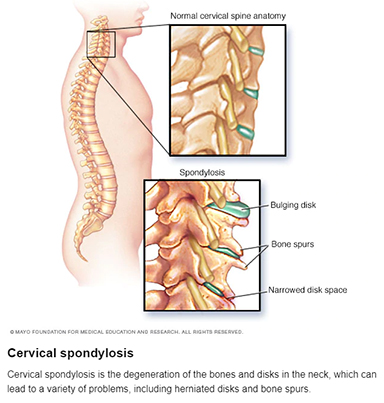 Symptoms
SymptomsFor most people, cervical spondylosis causes no symptoms. When symptoms do occur, they typically include pain and stiffness in the neck.
Sometimes, cervical spondylosis results in a narrowing of the space needed by the spinal cord and the nerve roots that pass through the spine to the rest of your body. If the spinal cord or nerve roots become pinched, you might experience:
- Tingling, numbness and weakness in your arms, hands, legs or feet
- Lack of coordination and difficulty walking
- Loss of bladder or bowel control
When to see a doctor
Seek medical attention if you notice a sudden onset of numbness or weakness, or loss of bladder or bowel control.
-
Herniated Disk
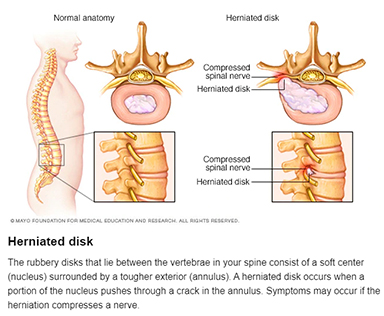 Symptoms
Symptoms
Most herniated disks occur in the lower back, although they can also occur in the neck. Signs and symptoms depend on where the disk is situated and whether the disk is pressing on a nerve. They usually affect one side of the body.
- Arm or leg pain. If your herniated disk is in your lower back, you'll typically feel the most pain in your buttocks, thigh and calf. You might have pain in part of the foot, as well. If your herniated disk is in your neck, you'll typically feel the most pain in your shoulder and arm. This pain might shoot into your arm or leg when you cough, sneeze or move into certain positions. Pain is often described as sharp or burning.
- Numbness or tingling. People who have a herniated disk often have radiating numbness or tingling in the body part served by the affected nerves.
- Weakness. Muscles served by the affected nerves tend to weaken. This can cause you to stumble, or affect your ability to lift or hold items.
You can have a herniated disk without symptoms. You might not know you have it unless it shows up on a spinal image.
When to see a doctor
Seek medical attention if your neck or back pain travels down your arm or leg, or if you also have numbness, tingling or weakness.
-
Spinal Stenosis
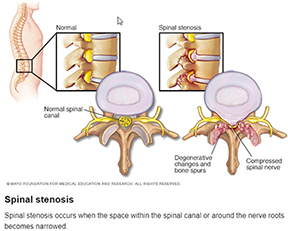 Symptoms
Symptoms
Many people have evidence of spinal stenosis on an MRI or CT scan but may not have symptoms. When they do occur, they often start gradually and worsen over time. Symptoms vary depending on the location of the stenosis and which nerves are affected.
In the neck (cervical spine)
- Numbness or tingling in a hand, arm, foot or leg
- Weakness in a hand, arm, foot or leg
- Problems with walking and balance
- Neck pain In severe cases, bowel or bladder dysfunction (urinary urgency and incontinence)
In the lower back (lumbar spine)
- Numbness or tingling in a foot or leg
- Weakness in a foot or leg
- Pain or cramping in one or both legs when you stand for long periods of time or when you walk, which usually eases when you bend forward or sit
- Back pain
When to see a doctor
See your doctor if you have any of the symptoms listed.
-
Strain
Symptoms
Signs and symptoms include:
- Pain that's often worsened by holding your head in one place for long periods, such as when driving or working at a computer
- Muscle tightness and spasms
- Decreased ability to move your head
- Headache
When to see a doctor
Most neck pain improves gradually with home treatment. If not, see your doctor.
Seek immediate care if severe neck pain results from an injury, such as a motor vehicle accident, diving accident or fall.
Contact a doctor if your neck pain:
- Is severe
- Persists for several days without relief
- Spreads down arms or legs
- Is accompanied by headache, numbness, weakness or tingling
Shoulder Pain
-
Bursitis
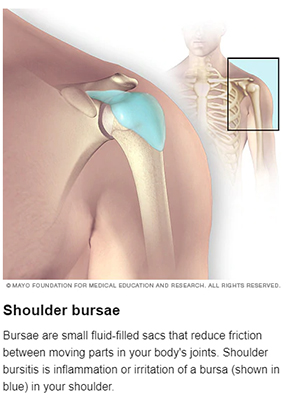 Symptoms
Symptoms
If you have bursitis, the affected joint might:
- Feel achy or stiff
- Hurt more when you move it or press on it
- Look swollen and red
When to see a doctor
Consult your doctor if you have:
- Disabling joint pain
- Sudden inability to move a joint
- Excessive swelling, redness, bruising or a rash in the affected area
- Sharp or shooting pain, especially when you exercise or exert yourself
- A fever
-
Frozen Shoulder
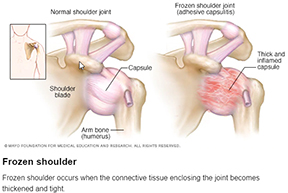 Symptoms
Symptoms
Frozen shoulder typically develops slowly, and in three stages. Each stage can last a number of months.
- Freezing stage. Any movement of your shoulder causes pain, and your shoulder's range of motion starts to become limited.
- Frozen stage. Pain may begin to diminish during this stage. However, your shoulder becomes stiffer, and using it becomes more difficult.
- Thawing stage. The range of motion in your shoulder begins to improve.
For some people, the pain worsens at night, sometimes disrupting sleep.
-
Rotator Cuff Tears
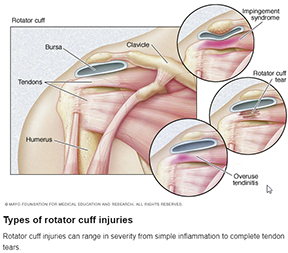 Symptoms
Symptoms
The pain associated with a rotator cuff injury may:
- Be described as a dull ache deep in the shoulder
- Disturb sleep
- Make it difficult to comb your hair or reach behind your back
- Be accompanied by arm weakness
When to see a doctor
Shoulder pain that is short-lived may be evaluated by your family doctor. See your doctor right away if you have immediate weakness in your arm after an injury.
-
Tendinitis
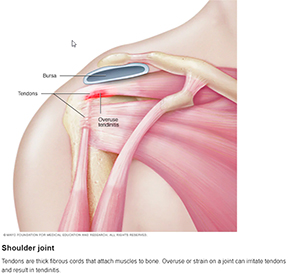 Symptoms
Symptoms
Signs and symptoms of tendinitis tend to occur at the point where a tendon attaches to a bone and typically include:
- Pain often described as a dull ache, especially when moving the affected limb or joint
- Tenderness
- Mild swelling
When to see a doctor
Most cases of tendinitis respond to self-care measures. See your doctor if your signs and symptoms persist and interfere with your daily activities for more than a few days.
Elbow Pain
-
Bursitis
 Symptoms
Symptoms
If you have bursitis, the affected joint might:
- Feel achy or stiff
- Hurt more when you move it or press on it
- Look swollen and red
When to see a doctor
Consult your doctor if you have:
- Disabling joint pain
- Sudden inability to move a joint
- Excessive swelling, redness, bruising or a rash in the affected area
- Sharp or shooting pain, especially when you exercise or exert yourself
- A fever
-
Golfer's Elbow
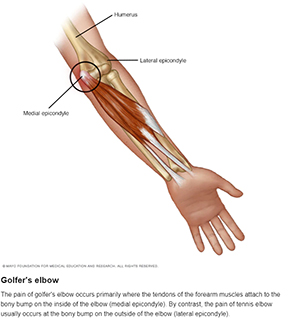 Symptoms
SymptomsGolfer's elbow is characterized by:
- Pain and tenderness. Usually felt on the inner side of your elbow, the pain sometimes extends along the inner side of your forearm. Pain typically worsens with certain movements.
- Stiffness. Your elbow may feel stiff, and making a fist might hurt.
- Weakness. You may have weakness in your hands and wrists.
- Numbness or tingling. These sensations might radiate into one or more fingers — usually the ring and little fingers.
The pain of golfer's elbow can come on suddenly or gradually. The pain might worsen with certain movements, such as swinging a golf club.
When to see a doctor
Consult your doctor if rest, ice and over-the-counter pain relievers don't ease your elbow pain and tenderness. Seek immediate care if:
- Your elbow is hot and inflamed, and you have a fever
- You can't bend your elbow
- Your elbow looks deformed
- You suspect you've broken a bone
-
Tennis Elbow
 Symptoms
Symptoms
The pain associated with tennis elbow may radiate from the outside of your elbow into your forearm and wrist. Pain and weakness may make it difficult to:
- Shake hands or grip an object
- Turn a doorknob
- Hold a coffee cup
When to see a doctor
Talk to your doctor if self-care steps such as rest, ice and use of over-the-counter pain relievers don't ease your elbow pain and tenderness.
Wrist/Hand Pain
-
Ganglion Cysts
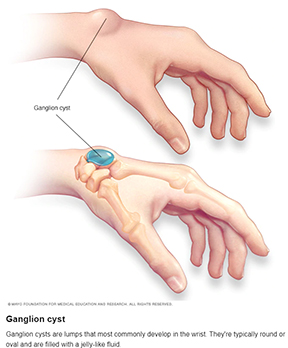 Symptoms
Symptoms
The lumps associated with ganglion cysts can be characterized by:
- Location. Ganglion cysts most commonly develop along the tendons or joints of your wrists or hands. The next most common locations are the ankles and feet. These cysts can occur near other joints as well.
- Shape and size. Ganglion cysts are round or oval and usually measure less than an inch (2.5 centimeters) in diameter. Some are so small that they can't be felt. The size of a cyst can fluctuate, often getting larger when you use that joint for repetitive motions.
- Pain. Ganglion cysts usually are painless. But if a cyst presses on a nerve — even if the cyst is too small to form a noticeable lump — it can cause pain, tingling, numbness or muscle weakness.
When to see a doctor
See your doctor if you experience a noticeable lump or pain in your wrist, hand, ankle or foot. He or she can make a diagnosis and determine whether you need treatment.
-
Tendinitis
Symptoms
Signs and symptoms of tendinitis tend to occur at the point where a tendon attaches to a bone and typically include:
- Pain often described as a dull ache, especially when moving the affected limb or joint
- Tenderness
- Mild swelling
When to see a doctor
Most cases of tendinitis respond to self-care measures. See your doctor if your signs and symptoms persist and interfere with your daily activities for more than a few days.
-
Trigger Finger
 Symptoms
Symptoms
Signs and symptoms of trigger finger may progress from mild to severe and include:
- Finger stiffness, particularly in the morning
- A popping or clicking sensation as you move your finger
- Tenderness or a bump (nodule) in the palm at the base of the affected finger
- Finger catching or locking in a bent position, which suddenly pops straight
- Finger locked in a bent position, which you are unable to straighten
Trigger finger can affect any finger, including the thumb. More than one finger may be affected at a time, and both hands might be involved. Triggering is usually more pronounced in the morning, while firmly grasping an object or when straightening your finger.
When to see a doctor
Seek immediate medical care if your finger joint is hot and inflamed, as these signs may indicate an infection.
If you have any stiffness, catching, numbness or pain in a finger joint, or if you can't straighten or bend a finger, make an appointment with your doctor.
Low Back Pain
-
Cervical Spondylosis (Disk Disease/Arthritis)
 Symptoms
Symptoms
For most people, cervical spondylosis causes no symptoms. When symptoms do occur, they typically include pain and stiffness in the neck.
Sometimes, cervical spondylosis results in a narrowing of the space needed by the spinal cord and the nerve roots that pass through the spine to the rest of your body. If the spinal cord or nerve roots become pinched, you might experience:
- Tingling, numbness and weakness in your arms, hands, legs or feet
- Lack of coordination and difficulty walking
- Loss of bladder or bowel control
When to see a doctor
Seek medical attention if you notice a sudden onset of numbness or weakness, or loss of bladder or bowel control.
-
Herniated Disk
 Symptoms
Symptoms
Most herniated disks occur in the lower back, although they can also occur in the neck. Signs and symptoms depend on where the disk is situated and whether the disk is pressing on a nerve. They usually affect one side of the body.
- Arm or leg pain. If your herniated disk is in your lower back, you'll typically feel the most pain in your buttocks, thigh and calf. You might have pain in part of the foot, as well. If your herniated disk is in your neck, you'll typically feel the most pain in your shoulder and arm. This pain might shoot into your arm or leg when you cough, sneeze or move into certain positions. Pain is often described as sharp or burning.
- Numbness or tingling. People who have a herniated disk often have radiating numbness or tingling in the body part served by the affected nerves.
- Weakness. Muscles served by the affected nerves tend to weaken. This can cause you to stumble, or affect your ability to lift or hold items.
You can have a herniated disk without symptoms. You might not know you have it unless it shows up on a spinal image.
When to see a doctor
Seek medical attention if your neck or back pain travels down your arm or leg, or if you also have numbness, tingling or weakness.
-
Spinal Stenosis
 Symptoms
Symptoms
Many people have evidence of spinal stenosis on an MRI or CT scan but may not have symptoms. When they do occur, they often start gradually and worsen over time. Symptoms vary depending on the location of the stenosis and which nerves are affected.
In the neck (cervical spine)
- Numbness or tingling in a hand, arm, foot or leg
- Weakness in a hand, arm, foot or leg
- Problems with walking and balance
- Neck pain
- In severe cases, bowel or bladder dysfunction (urinary urgency and incontinence)
In the lower back (lumbar spine)
- Numbness or tingling in a foot or leg
- Weakness in a foot or leg
- Pain or cramping in one or both legs when you stand for long periods of time or when you walk, which usually eases when you bend forward or sit
- Back pain
When to see a doctor
See your doctor if you have any of the symptoms listed.
-
Strain
Symptoms
Back pain can range from a muscle aching to a shooting, burning or stabbing sensation. In addition, the pain may radiate down your leg or worsen with bending, twisting, lifting, standing or walking.
When to see a doctor
Most back pain gradually improves with home treatment and self-care, usually within a few weeks. Contact your doctor if your back pain:
- Persists past a few weeks
- Is severe and doesn't improve with rest
- Spreads down one or both legs, especially if the pain extends below the knee
- Causes weakness, numbness or tingling in one or both legs
- Is accompanied by unexplained weight loss
In rare cases, back pain can signal a serious medical problem. Seek immediate care if your back pain:
- Causes new bowel or bladder problems
- Is accompanied by a fever
- Follows a fall, blow to your back or other injury
Hip Pain
-
Bursitis
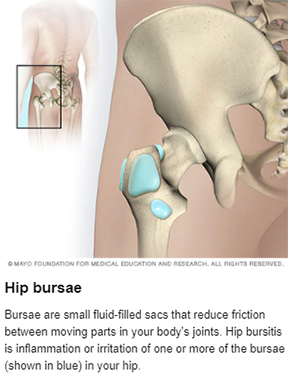 Symptoms
Symptoms
If you have bursitis, the affected joint might:
- Feel achy or stiff
- Hurt more when you move it or press on it
- Look swollen and red
When to see a doctor
Consult your doctor if you have:
- Disabling joint pain
- Sudden inability to move a joint
- Excessive swelling, redness, bruising or a rash in the affected area
- Sharp or shooting pain, especially when you exercise or exert yourself
- A fever
-
Impingement
Hip impingement occurs when the ball and socket of the hip joint don't fit together properly. The restricted motion damages cartilage and can cause pain and arthritis in young adults.
In some cases, the ball is too misshapen to fit properly into the socket. Sometimes, the exterior edge of the socket extends to the point that it covers too much of the ball. Hip impingement also can be caused by a combination of these two problems.
Most people with hip impingement experience pain in the groin area during or after flexing the hip, as when running, jumping or sitting for a long time. You may also have difficulty flexing your hip beyond a right angle.
Surgery may be required to prevent further hip injury.
-
Tendinitis
Symptoms
Signs and symptoms of tendinitis tend to occur at the point where a tendon attaches to a bone and typically include:
- Pain often described as a dull ache, especially when moving the affected limb or joint
- Tenderness
- Mild swelling
When to see a doctor
Most cases of tendinitis respond to self-care measures. See your doctor if your signs and symptoms persist and interfere with your daily activities for more than a few days.
Knee Pain
-
Baker's Cyst
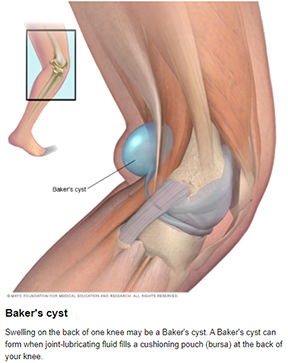 Symptoms
Symptoms
In some cases, a Baker's cyst causes no pain, and you may not notice it. If you do have signs and symptoms, they might include:
- Swelling behind your knee, and sometimes in your leg
- Knee pain
- Stiffness and inability to fully flex the knee
Your symptoms may be worse after you've been active or if you've been standing for a long time.
When to see a doctor
If you have pain and swelling behind your knee, see your doctor. Though unlikely, a bulge behind your knee may be a sign of a condition more serious than a fluid-filled cyst.
-
Iliotibial Band Syndrome
This occurs when the tough band of tissue that extends from the outside of your hip to the outside of your knee (iliotibial band) becomes so tight that it rubs against the outer portion of your femur. Distance runners and cyclists are especially susceptible to iliotibial band syndrome.
-
Meniscus Tears
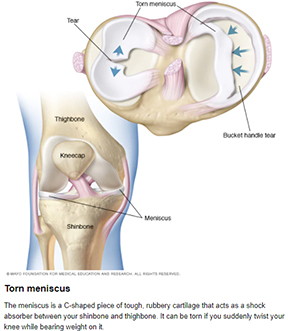 Symptoms
Symptoms
If you've torn your meniscus, you might have the following signs and symptoms in your knee:
- A popping sensation
- Swelling or stiffness
- Pain, especially when twisting or rotating your knee
- Difficulty straightening your knee fully
- Feeling as though your knee is locked in place when you try to move it
- Feeling of your knee giving way
When to see a doctor
Contact your doctor if your knee is painful or swollen, or if you can't move your knee in the usual ways.
-
Sprain
Symptoms
Open pop-up dialog box Signs and symptoms will vary, depending on the severity of the injury, and may include:
- Pain
- Swelling
- Bruising
- Limited ability to move the affected joint
- Hearing or feeling a "pop" in your joint at the time of injury
When to see the doctor
Mild sprains can be treated at home. But the injuries that cause sprains can also cause serious injuries, such as fractures. You should see a doctor if you:
- Can't move or bear weight on the affected joint
- Have pain directly over the bones of an injured joint
- Have numbness in any part of the injured area
-
Tendinitis
Symptoms
Signs and symptoms of tendinitis tend to occur at the point where a tendon attaches to a bone and typically include:
- Pain often described as a dull ache, especially when moving the affected limb or joint
- Tenderness
- Mild swelling
When to see a doctor
Most cases of tendinitis respond to self-care measures. See your doctor if your signs and symptoms persist and interfere with your daily activities for more than a few days.
Foot and Ankle Pain
-
Plantar Fasciitis
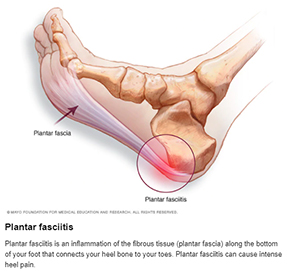 Symptoms
Symptoms
Plantar fasciitis typically causes a stabbing pain in the bottom of your foot near the heel. The pain is usually the worst with the first few steps after awakening, although it can also be triggered by long periods of standing or when you get up after sitting. The pain is usually worse after exercise, not during it.
-
Shin Splints
Symptoms
If you have shin splints, you might notice tenderness, soreness or pain along the inner side of your shinbone and mild swelling in your lower leg. At first, the pain might stop when you stop exercising. Eventually, however, the pain can be continuous and might progress to a stress reaction or stress fracture.
When to see a doctor
Consult your doctor if rest, ice and over-the-counter pain relievers don't ease your shin pain.
-
Sprains
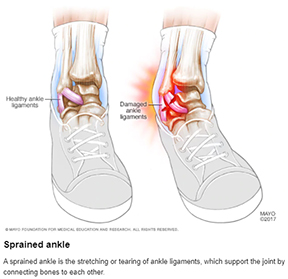 Symptoms
SymptomsSigns and symptoms will vary, depending on the severity of the injury, and may include:
- Pain
- Swelling
- Bruising
- Limited ability to move the affected joint
- Hearing or feeling a "pop" in your joint at the time of injury
When to see the doctor
Mild sprains can be treated at home. But the injuries that cause sprains can also cause serious injuries, such as fractures. You should see a doctor if you:
- Can't move or bear weight on the affected joint
- Have pain directly over the bones of an injured joint
- Have numbness in any part of the injured area
-
Tendinitis
Symptoms
Signs and symptoms of tendinitis tend to occur at the point where a tendon attaches to a bone and typically include:
- Pain often described as a dull ache, especially when moving the affected limb or joint
- Tenderness
- Mild swelling
When to see a doctor
Most cases of tendinitis respond to self-care measures. See your doctor if your signs and symptoms persist and interfere with your daily activities for more than a few days.
Fractures
-
Compression Fractures
The bones that make up your spine (vertebrae) can weaken to the point that they crumple, which may result in back pain, lost height and a hunched posture.

-
Stress Fracture
 Symptoms
Symptoms
At first, you might barely notice the pain associated with a stress fracture, but it tends to worsen with time. The tenderness usually starts at a specific spot and decreases during rest. You might have swelling around the painful area.
When to see a doctor
Contact your doctor if your pain becomes severe or if you feel pain even when resting or at night.
Arthritis
-
Overview
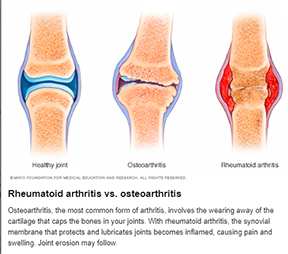 The most common signs and symptoms of arthritis involve the joints. Depending on the type of arthritis you have, your signs and symptoms may include:
The most common signs and symptoms of arthritis involve the joints. Depending on the type of arthritis you have, your signs and symptoms may include:
- Pain
- Stiffness
- Swelling
- Redness
- Decreased range of motion
Nerve Disorders
-
Carpal Tunnel Syndrome
Symptoms
Carpal tunnel syndrome symptoms usually start gradually and include:
- Tingling or numbness. You may notice tingling and numbness in your fingers or hand. Usually the thumb and index, middle or ring fingers are affected, but not your little finger. You might feel a sensation like an electric shock in these fingers.
The sensation may travel from your wrist up your arm. These symptoms often occur while holding a steering wheel, phone or newspaper, or may wake you from sleep.
Many people "shake out" their hands to try to relieve their symptoms. The numb feeling may become constant over time. - Weakness. You may experience weakness in your hand and drop objects. This may be due to the numbness in your hand or weakness of the thumb's pinching muscles, which are also controlled by the median nerve.
When to see a doctor
See your doctor if you have signs and symptoms of carpal tunnel syndrome that interfere with your normal activities and sleep patterns. Permanent nerve and muscle damage can occur without treatment.
- Tingling or numbness. You may notice tingling and numbness in your fingers or hand. Usually the thumb and index, middle or ring fingers are affected, but not your little finger. You might feel a sensation like an electric shock in these fingers.
-
Sciatica
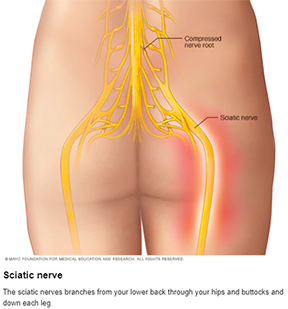 Symptoms
Symptoms
Pain that radiates from your lower (lumbar) spine to your buttock and down the back of your leg is the hallmark of sciatica. You might feel the discomfort almost anywhere along the nerve pathway, but it's especially likely to follow a path from your low back to your buttock and the back of your thigh and calf.
The pain can vary widely, from a mild ache to a sharp, burning sensation or excruciating pain. Sometimes it can feel like a jolt or electric shock. It can be worse when you cough or sneeze, and prolonged sitting can aggravate symptoms. Usually only one side of your body is affected.
Some people also have numbness, tingling or muscle weakness in the affected leg or foot. You might have pain in one part of your leg and numbness in another part.
When to see a doctor
Mild sciatica usually goes away over time. Call your doctor if self-care measures fail to ease your symptoms or if your pain lasts longer than a week, is severe or becomes progressively worse. Get immediate medical care if:
- You have sudden, severe pain in your low back or leg and numbness or muscle weakness in your leg
- The pain follows a violent injury, such as a traffic accident
- You have trouble controlling your bowels or bladder

